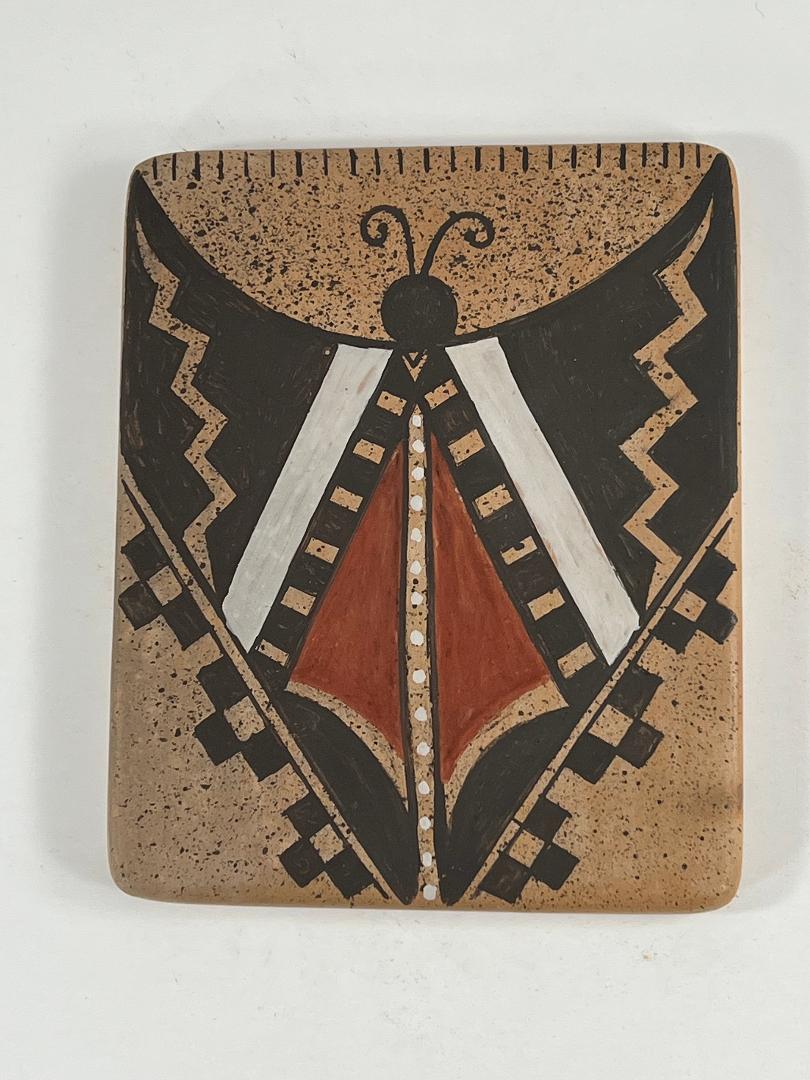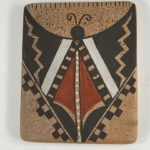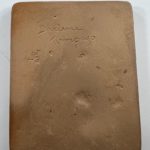This collection has more than two dozen pots carrying images of butterflies. (See “Category” list.) Its easy to love these flying flowers, but in addition, butterflies at Hopi are a sign that rain has fallen, the desert is blooming and there is hope for “siitalpuva,”
“a colorful, glittering, flowery, paradise evoked through singing, and the sounds of bells, rattles, flutes and songs. Hopi songs describe siitalpuva, ‘along (or throughout) the flowery land,’ ‘along the fields in bloom,’ ‘the land brightened with flowers,’ as a place that ‘shines forth’ with colored blossoms, birds and butterflies. This flowerey world is not a separate place, like the Christian Heaven, but a reality that can be brought forth in this world through human prayers, songs and actions (Hays-Gilpin and Schaafsma, 2010:122).”
Of the many butterflies that fly around within this collection, the depiction on tile 2021-14 is both the largest and the most dramatic, perhaps just the kind of emphatic hope I need as I sit here writing this in the midst of a pandemic, enormous economic inequality, and climate change.
Form:
The form is a flat rectangle, its dimensions noted above. Although seemingly a simple shape, tiles are notoriously difficult to make since the wet clay tends to curl when drying. Darlene is known for her tiles, however, and has apparently found a way to control the curling demon. Her name and corn clan symbol are inscribed on the back, which also shows light impressions from some sort of mat on which the clay was left to dry.
Design:
The design is a single, huge, butterfly that completely fills the top surface of the tile, only leaving room around its edges. What background is visible is speckled with tiny drops of black paint. The top edge of the butterfly is a simple swag attached to each of the top corners of the tile. At the center of this curve, in the residual speckled space, is a large, solid black ball, the butterfly’s head. Emerging from its top are two antennae with curlicue ends.
The pattern of the body of the butterfly is a mosaic of triangular shapes, though often these are modified. Starting just below the base of the head, an unpainted “one lane highway” runs downward the length of the design. Fifteen white dots are strung along the length of this passageway, like pearls on a necklace. At the lower end of this “highway” two additional one-lane highway elements emerge, moving upward and obliquely away from each other, thus forming a large “V.” (V#1.) The tip of this V needs to be imagined since it seems to lie just off the lower edge of the tile. Almost all of the butterfly lies below swag emerging from the top corners of the tile and inside V#1, which terminates halfway up the sides of the tile. The central one lane highway (with pearls) divides the right wing from the left. The designs on the wings mirror each other.
Starting at the head an inverted “V” (V#2), consisting of thick black bands with 5 unpainted rectangles in each leg, expands as it moves downward before terminating at the sides of V#1 halfway along their length. This calisthenic geometry defines a central diamond-shaped form that is within both V#1 and V#2 and spreads over both wings. Against the inside lower edges of this shape are the bases of black hills, one on each wing. Just above their upper curved edge is a thin unpainted arc. The remainder of the diamond shape is solid red. Since this form is split by the central highway, each side can be seen as an isosceles triangle, though its base is slightly concave.
Against the outer edges of V#2 are thick white stripes. From these stripes to the edge of the tile the wings are solid black, except that running from the lower edge of this section to its upper edge is an unpainted, 8-pointed, zig-zag line. This design displays “foreground/background reversal” where the viewer sees the foreground and background regularly shift position. Thus this section can also be seen as two large sawtoothed black elements with a line of speckled unpainted background between them.
Finally, external to the sides of V#1 is a design of three black squares arranged in a pyramid, its center open. This stepped shape is repeated three times on each side of the V.
Design analysis:
The three colors used in the design are all solid and emphatic. They fill different functions, however. Red focuses our attention to the center of the design; white brightens the design; black frames these areas of color and highlights them.
Butterflies are symmetrical and so is the arrangement of the elements of design. The two defining V-shapes are reciprocal and pull a viewer’s eye in opposite directions but they are also balanced. V-shape #1 terminates halfway along the edge of the tile; V-shape #2 terminates halfway along the length of V-shape #1. Balance among difference.
The stepped triangles on the fringe of the wings keep the butterfly from being a solid image and this lightens the design. The foreground/background reversal of the two zig-zag elements energize the design, though not with quite enough energy to allow the butterfly to float off the tile. The tiny drops of black paint on the otherwise unpainted surface are said to represent rain, and rain triggers the birth of butterflies in the Hopi desert. Both are heralds of siitalpuva, a large longing for such a small tile.



